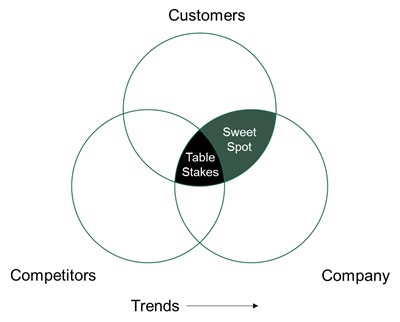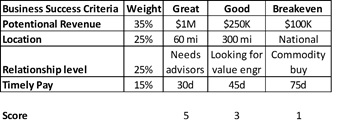Last entry, we introduced the “3C Needs Map.” This chart helps you compare what you offer to what competitors offer and what customers want. The areas where the circles overlap reveal where your business’ “sweet spot” lies—and where, on the flip side, your competitors win out. The center of the chart shows the “table stakes,” or the minimum requirements you need to successfully sell in your market.
The 3C Needs Map allows you to see what makes you different—so that you can focus on the customers who truly want what you’re selling. The diagram also makes clear that there are some customers whose needs you meet better than others.
In the last post, we explained that your sweet spot is where your differentiators lie—the things you offer that customers want and no competitors can deliver. But there’s another thing you should know about the sweet spot: you don’t want to lure just anybody here.
The trouble with your sweet spot is that it can attract customers who mean well and buy regularly, but who are nonetheless a poor fit for your business. For example, these customers could be smaller than desired, geographically distant, or habitually late with their payments. You keep filling their requests, but you might be only breaking even—or even losing money in the process.
How do you focus on your differentiating capabilities—your sweet spot—without attracting customers that are a poor fit? You need to have the right tools to select the right customers.
Most companies apply what Grow MFG calls the “mirror test” to determine whether a customer is a good fit. In other words, if a customer can fog a mirror, they’re worth pursuing. Unfortunately, this catchall test doesn’t always tell you whether a prospect will be a good customer. Instead, businesses should be more methodical: use not a mirror, but a compass.
How? The first step is to precisely define what makes for a great customer. If you understand exactly who your ideal customer is, you’ll be better able to select your customers.
Begin by listing any criteria that matter to you in your relationship with a customer. These could include a customer company’s size, their distance from you, the type of relationship they are interested in, or other factors. Assign each criterion a weight—a percentage out of 100—based on its relative importance to you. Then, define on each of your criteria what would make for a great customer, a good customer, and your “breakeven point” (the point below which you’d be better off turning a customer away).
You can use a chart like this to evaluate all potential customers and even your existing ones. Simply identify where a potential customer falls on each of your criteria, multiply each response by the criterion’s weight, and then add all responses together to get your final score.
For example, let’s say you identify a new customer that has potential revenue of $100K, is within 60 miles of your company, needs advisory capabilities, and has a reputation for paying within 45 days. Using the weights above, the customer would have a score of 3.30. Even though the potential revenue is at the breakeven level, this calculation reveals that are a good potential customer overall.
This tool can help you grow by selecting customers that are a good fit for you. And the 3C Needs Map can help you see if you are a good fit for those customers.
After defining your perfect customer, it’s time to better understand what your great customers want from you. Next entry, we’ll explain how to do just that.




